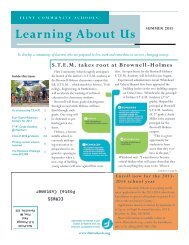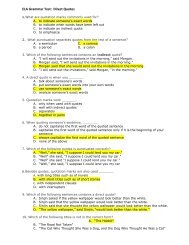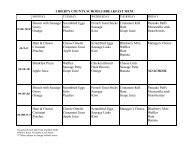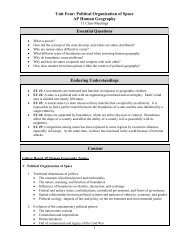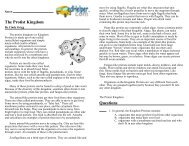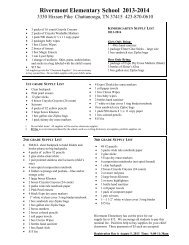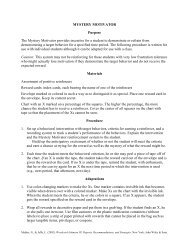The First Civilizations - Baby's First Year
The First Civilizations - Baby's First Year
The First Civilizations - Baby's First Year
Create successful ePaper yourself
Turn your PDF publications into a flip-book with our unique Google optimized e-Paper software.
Copyright © by <strong>The</strong> McGraw-Hill Companies, Inc.<br />
Name Date Class<br />
READING ESSENTIALS AND STUDY GUIDE 1-1 (continued)<br />
<strong>The</strong>y cared for the children and searched nearby woods<br />
for berries, nuts, and grains.<br />
Men hunted animals. This sometimes took them far<br />
from camp. Men had to learn the habits of different animals.<br />
<strong>The</strong>y also needed to make tools for the kill. <strong>The</strong><br />
earliest tools, such as clubs were used for such a purpose.<br />
Men also killed animals by driving them off cliffs. Later,<br />
people invented spears, traps, and bows and arrows.<br />
Adapting to the Environment <strong>The</strong> way Paleolithic people lived<br />
depended on where they lived. Those in warm climates<br />
needed little clothing or shelter. People in cold climates<br />
needed more. Many lived in caves. Over time, people created<br />
new kinds of shelters, such as animal hides held up<br />
by wooden poles.<br />
Paleolithic people also learned to tame fire. Fire was<br />
important for many reasons. It provided warmth and<br />
light. It scared away wild animals. Food cooked over a<br />
fire tasted better, was easier to digest, and would keep<br />
longer. People also could now save meat by having it<br />
smoked over fire.<br />
Archaeologists believe that fires were first started by<br />
rubbing two pieces of wood together and later with drilllike<br />
tools.<br />
What Were the Ice Ages? Fire helped people survive the Ice<br />
Ages. From 100,000 B.C. to about 8000 B.C., thick ice sheets<br />
covered parts of Europe, Asia, and North America.<br />
During the Ice Ages, people were at constant risk from<br />
cold and hunger. To survive, early humans had to adapt.<br />
People had to build sturdier shelters, make warmer clothing,<br />
and change their diets. Fire helped them live in this<br />
harsh environment.<br />
Language, Art, and Religion Paleolithic people developed language.<br />
This made it easier for people to work together<br />
and pass on knowledge. Early people used both words<br />
and art. <strong>The</strong>y made paint from crushed rocks. <strong>The</strong>y<br />
painted animals on cave walls.<br />
Some historians believe the early art could have had religious<br />
meaning or was meant to bring hunters good luck.<br />
3



